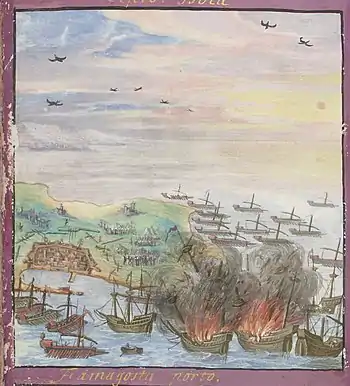
Arnaude de Rocas (Μαρία Συγκλητική[1] Maria Syglitiki, aka Arnalda di Roca;[2][3] died 1570) is a legendary personality from Cyprus, remembered there as a martyr[4] and a Cypriot heroine.[5]
Biography
According to legend, Maria (Arnalda) was the daughter of Eugene Syglitikos (Zegno Singlitico, count of Roccas/Rochas),[6][3][7] who was killed in battle when the Ottoman Turks took Nicosia, capital of Cyprus, on 9 September 1570 after a long siege.[8] Allegedly, she died in an explosion one or two days thereafter.[4] It is said that she managed to set fire to the powder kegs of the ship, while the ship was still in Famagusta Bay.[9]
Arnaude had come to the front lines to help prepare bandages for the wounded fighters who were defending the fort, which was the custom for women at that time.[4] The defending forces repelled two assaults, but not the third, and the fortress fell.[4] Arnaude hid in an underground chapel with her father, Nicolo Dandolo, leader of the defending forces, where she tended to his mortal wounds.[10] When Turkish soldiers found the daughter and her dying father, Arnaude's captors indicated that she would be destined for slavery in the harem of the Sultan Selim.[10]
She was taken to the central square where she joined about 800 other young Cypriot women who were also bound for enslavement in Turkey. The women were loaded onto a ship at the port of Limassol, Cyprus. The ship was scheduled to sail the next day for Constantinople, modern day Istanbul, Turkey. During the night, however, the entire vessel exploded killing everyone on board including the young women who had all, it is reported, chosen death rather than slavery. Arnaude is credited with causing the explosion by using a lamp to set fire to the ship's powder store as the guards slept.[10][11][12]
References
- ↑ Μαρία Συγκλητική, polignosi.com (in Greek).
- ↑ Antonio Luigi Basso: Arnalda di Roca, Sambolino (tip.), 1871
- 1 2 Συγκλητικοί οικογένεια - Η θρυλική οικογένεια των Συγκλητικών της Κύπρου, polignosi.com (in Greek).
- 1 2 3 4 Journal des demoiselles (in French). Bureau du journal. 1838.
- ↑ Celebrating the 1821 Bicentennial, pahellenicfoundation.org
- ↑ "Zegno II was the son of Count Zacho I. He spent his adult life partly in Cyprus and partly in Venice. From 1551 to 1553 he served as viscount of Nicosia and ten years later, following the death of his father, he inherited the title of count of Roccas." in: M. Olympios and M. Parani (eds): The Art and Archaeology of Lusignan and Venetian Cyprus (1192–1571), academia.edu, p. 332 and p.345
- ↑ Benjamin Arbel: Greek Magnates in Venetian Cyprus: The Case of the Synglitico Family, jstor.org
- ↑ 3.2. The siege and conquest of Lefkosia, in ESCUTIS Cyprus study, earthlab.uoi.gr, p.12
- ↑ "Amongst the captives was Maria Syglitiki, a Greek noblewoman, who refusing to be disgraced, managed to set fire to the powder kegs of the ship, while the ship was still in Famagusta Bay.": 3.2. The siege and conquest of Lefkosia, in ESCUTIS Cyprus study, earthlab.uoi.gr, p.13
- 1 2 3 Bedolliere, Emile de la (1838). "Arnaude de Rocas: episode de l'histoire de Chypre en 1570". Journal des demoiselles. Bureau du journal. pp. 32–34. Retrieved 14 October 2017.
- ↑ Riballier, Philibert; et al. (1779). De l'éducation physique et morale des femmes, avec une notice alphabétique de celles qui se sont distinguées dans les différentes carrieres des sciences & des beaux-arts, ou par des talens & des actions mémorables. chez les frères Estienne libraires. p. 126. Retrieved 14 October 2017.
- ↑ Hays, Mary (1807). "Arnaude de Rocas". Female Biography, vol 3. Philadelphia: Printed for Byrch and Small. p. 147. Retrieved 14 October 2017.